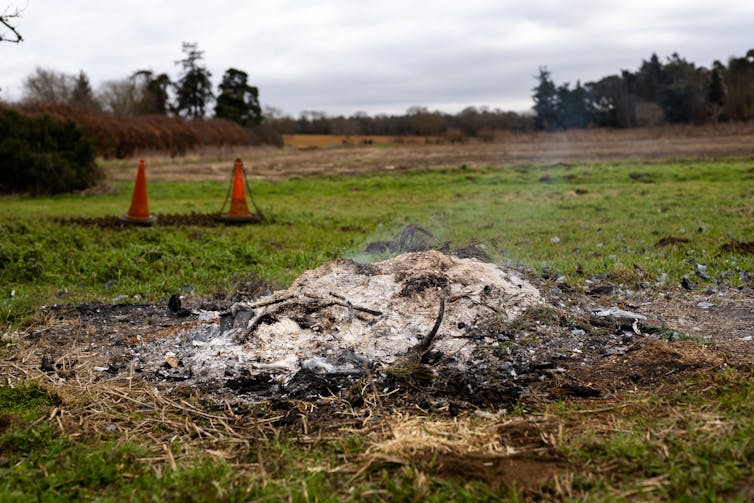Source: ForeignAffairs4
Source: The Conversation – UK – By Elliot David Convery-Fisher, Research Fellow in the Socio-Ecology of Fire Management, Royal Botanic Garden Edinburgh
For the tenth time this year, a wildfire warning covers most of Scotland. The latest alert came after a recent, and not the first, gorse fire on Arthur’s Seat, Edinburgh’s iconic ancient volcano that draws millions of visitors every year. Fire crews think human activity caused the fire. This is exactly the kind of incident that triggers our instinct to find someone to blame.
But with over 41,000 hectares already burned across Britain in 2025 (an area larger than the Isle of Wight) pointing the finger misses the point. News reports focus on who lit the spark, but Arthur’s Seat was primed to burn: flammable gorse has flourished since sheep stopped grazing the slopes. The real question isn’t who started this fire, but why we are caught off guard when fires happen in the wrong places.
This isn’t just an Edinburgh problem. Millions of Britons live near fire-prone landscapes, from Dorset heathlands to the Scottish Highlands.
My colleagues and I work with national parks in southern Africa to understand how they manage this challenge. The challenges I see in South Africa mirror what Britain now faces because of climate change: how to keep people and infrastructure safe when fire an unavoidable part of our reality.
Research shows that climate change has made the UK’s risk of ideal conditions for wildfires six times higher. While ignition sources haven’t changed much – most UK fires still start from human activity like discarded cigarettes or campfires – the conditions that allow fires to spread have transformed. Warmer, wetter winters create more plant growth and therefore fuel, which turns bone-dry during hot, dry spells.

Simon Collins/Shutterstock
Fire is a natural and vital feature of many landscapes globally. In fire-adapted ecosystems it can clear invasive species while promoting native grasses, reduce the buildup of dead vegetation that fuels dangerous blazes and create some of our most iconic places where plants and animals thrive.
The problem isn’t fire itself, but where, when and how it happens. Over 1.8 million British homes now sit within 100m of countryside edges – exactly where most wildfires occur. During one of Britain’s biggest wildfires on a North Yorkshire moor in 2018, flames nearly reached homes and critical infrastructure: the trans-Pennine railway, M62 motorway, major power lines and drinking water reservoirs. Another recent fire in the same area was close to a ballistic missile base.
I have interviewed fire managers in South Africa, where humans have worked with fire for millennia. Their approach suggests a fundamentally different relationship with fire, understanding fire as part of a landscape’s natural processes. Instead of treating every fire as a crisis, they study how fire behaves – when it helps ecosystems, when it threatens communities, and how to work with these patterns rather than against them.
Take Cape Town as an example, where fire authorities publish daily risk ratings that residents check like weather forecasts. High-risk days mean banned barbecues and closed trails. When safe, fire crews deliberately burn mountain slopes in small sections – having the right fires at the right times to prevent catastrophic ones. Property owners in Cape Town form neighbourhood fire protection associations to support each other and the emergency services during unplanned fires, creating a coordinated response network.
The UK is catching on
The UK government is reviewing its wildfire management strategy, focusing on prevention, collaboration and risk reduction. Landowners are also taking a more proactive approach. The Cairngorms national park in Scotland approved the UK’s first comprehensive wildfire management plan in June 2025, introducing seasonal fire management plans and setting up community groups to communicate fire risk and response. Fire services in the Cairngorms now use drones for real-time aerial mapping and off-road vehicles to fight fires in tough terrain.
However, we are still playing catch up. Fire services recorded 286 wildfires between January and April 2025. That’s over 100 more than the same period in 2022’s record year. Yet services receive little dedicated wildfire funding.
Britain could learn from South Africa’s holistic approach. Starting with the need to understand our own landscapes first. What role does fire play in our landscapes? How can we safely manage fire risk in different landscape types? Which of our ecosystems and places might actually benefit from carefully managed fire?
Edinburgh could start by studying Arthur’s Seat as Cape Town studies Table Mountain – not to implement identical solutions, but to understand how fire behaves in this specific landscape. This means researching how gorse burns, whether controlled burns could reduce dangerous fuel loads, and how visitors can safely coexist with proactive fire management.
The lesson isn’t to transplant South African methods to British soil, but to embrace their comprehensive approach to understanding fire. Every landscape is different. What works on Cape Town’s fynbos shrubland won’t necessarily work on Scottish moors. But the principle of studying fire as a part of the landscape rather than simply an emergency to suppress could transform how Britain manages its growing fire risk.
Fire isn’t the enemy. Poorly understood, unmanaged fire is. Climate change guarantees greater fire risk. Britain’s choice is clear: continue reacting with shock to each blaze, or develop our own integrated understanding of how fire works in British landscapes. The Arthur’s Seat fire was a warning shot. The question is whether we’ll heed it.
Don’t have time to read about climate change as much as you’d like?
Get a weekly roundup in your inbox instead. Every Wednesday, The Conversation’s environment editor writes Imagine, a short email that goes a little deeper into just one climate issue. Join the 45,000+ readers who’ve subscribed so far.
![]()
Elliot David Convery-Fisher works for the Royal Botanic Gardens Edinburgh and the University of Edinburgh. He receives funding from UK International Development through the Biodiverse Landscapes Fund project ‘Achieving Sustainable Forest Management through Community Protected Areas in Madagascar’ (ecm 62237).
– ref. Why the Arthur’s Seat burn is a cautionary tale for the UK’s wildfire management strategy – https://theconversation.com/why-the-arthurs-seat-burn-is-a-cautionary-tale-for-the-uks-wildfire-management-strategy-263065
